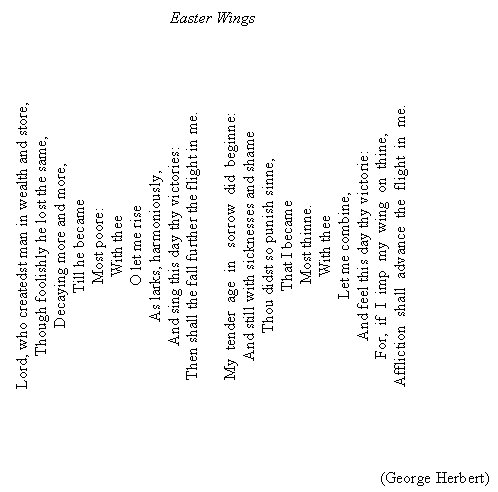 |
 |
Self Assessment Instructions
Before beginning the self assessment activity proper, you need to complete
your own analysis. But to simplify the task, we want you to look in detail
at three language levels:
-
Graphological Deviation
-
Syntactic Parallelism
-
Vocabulary
Please follow the instructions below:
-
Firstly, read through the following poem several times so that your
are familiar with it.
We suggest that you print
the printer friendly version of this page and do your work on
the poem using a word processor. Then you can copy and paste your
analysis into the self assessment mechanism.
Even if you do decide to work directly on the self-assessment page
it will be important for you save your work to a disk or print it
off, so that you do not lose it.

Note:
The spellings are as in the original. In the seventeenth century,
when the poem was written, the verb ‘imp’ could have the
meaning ‘graft/engraft’ and could specifically be used to
refer to the repairing of the damaged feathers of a bird’s wing
as well as the grafting of plants. It could also occur metaphorically
in religious contexts.
See the relevant entry in the full Oxford English Dictionary (OED)
if you want to follow this up.
-
Now write down for your future reference a brief account of your
general understanding of the text, including its general topic, its
style, or any specific overall effects you think the author wanted
to produce. This intuitive statement then becomes the interpretative
hypothesis that your later analysis will relate to. You can then keep
comparing your analytical results to see how they relate to that hypothesis.
You may find that you need to alter your hypothesis to a greater or
lesser degree, depending upon what you find. Alternatively, you may
find that you don’t need to alter your initial interpretative
hypothesis very much, if at all. But you should find that your analysis
will help to explain your interpretation in more detail and greater
depth.
-
If you were doing a complete stylistic analysis from scratch, your
would need to look carefully and systematically at the sorts of linguistic
features we have discussed on the course, at each linguistic level.
You should also refer to relevant checksheets from the course and
from the textbook in order to make sure that you don't miss anything
significant.
-
Now, having completed the analytical tasks, go back to your original
interpretative
comments from (2) above. Has your understanding of the text been affected
in any way (e.g. changed, deepened, etc.)? If so, write down how.
This will help you to understand the benefit of doing stylistic analysis.
-
When you have completed the above tasks, you should write up a finished
version. It is important that you structure your analysis by dividing
it into sections. Start off with your own general interpretation of
the text. Then proceed to the analysis proper, and structure it according
to the three levels indicated above, linking your analysis at each
stage back to your initial, general interpretation.
-
Save your work to a floppy, so that you can copy and paste your analysis
into the self-assessment exercise.
-
You're now ready to (i) compare your analysis with responses from
other students, (ii) check out the level that you are achieving, and
(iii) see what improvements you can make.

|

